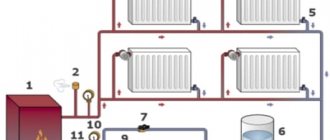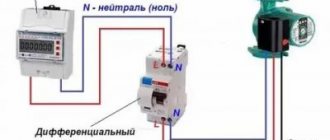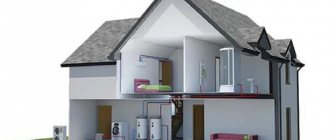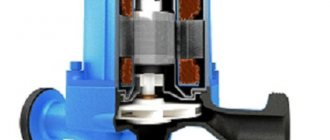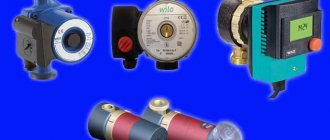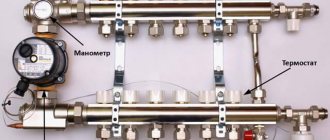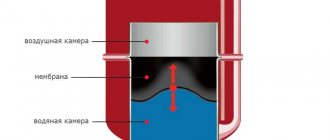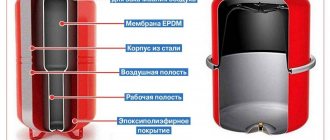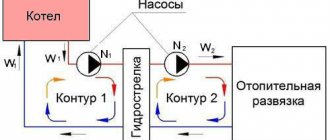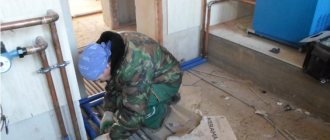The operation of modern heating systems that use forced movement of coolant through heating circuits would be impossible without a circulation pump.
Selection of circulation pump
It is this device that ensures the movement of coolant along the lines of the heating system, underfloor heating system, and hot water recirculation system. In complex multi-circuit systems of houses with a large area and number of floors, there may be several such pumps.
The effective heat transfer of a heating system directly depends on the compliance of the parameters of the circulation pump with the parameters of the system as a whole. To navigate the topic ,
how to choose a circulation pump for a heating system, let’s get acquainted with its structure and main parameters.
Pump device
Sectional view of a circulation pump
Design of a “dry” type pump
Let’s look at the cross-section of the pump. It consists of the pump itself and an electric motor with a control unit. The body material can be: stainless steel, bronze, aluminum, cast iron. An impeller made of stainless steel or technopolymer, fixed to the motor shaft, by its rotation creates a forced movement of fluid through the pump. The axes of the inlet pipe and the outlet axis are usually located along the same line. The bearings and shaft of modern circulation pumps are made of ceramic, which has a beneficial effect on the noise level and durability of the device.
Technical parameters of the circulation pump
The functionality of the device can be found in its technical data sheet. Knowledge of the following parameters will help you choose a circulation pump for heating:
- Pump flow (flow, productivity) is a volumetric value (unit - m3/h), numerically equal to the maximum volume of water that the pump can pump through itself in one hour.
- The pressure of the circulation pump is the maximum value of hydraulic resistance that all elements of the heating circuits provide to the movement of liquid, and which the pump is able to overcome (at its flow rate = 0). Measured in m (meters).
- Pump characteristic is a derived quantity determined by the relationship between the pump pressure and its performance. So for a single-mode (single-speed) pump there is only one characteristic, for two or more - respectively two and... What can we say about pumps with continuously variable output?..
Calculation formulas
Without carrying out the calculations below, it is not possible to select the right pump, so this point is simply indispensable.
Productivity
This parameter in calculations is usually denoted by the letter Q and shows how much heat can be moved by the pump per unit time.
The formula looks like this:
Where:
- Q —volume flow, m 3 /h;
- R — required power for the room, kW;
- TF is the value of the liquid temperature at the system inlet, ᵒС;
- TR is the temperature of the liquid at the outlet of the system, ᵒС.
The value of R in European countries is usually taken:
- 100 kW/m 3 – for a private house with no more than two apartments.
- 80 kW/m 3 – for large apartment buildings.
Napor
The value of pressure (pressure) does not depend on the height of the building, but on its hydraulic resistance, so this is what needs to be calculated.
Formula:
Where:
- Nn – pressure value, m.
- I – total pipeline length, m.
- R – friction resistance of a straight pipe, Pa/m.
- ZF – safety factors, which is equal to:
- 1,2 – for the mixer and natural circulation device;
- 1.3 – for fittings and fittings;
- 1.7 – for TV;
Classification of circulation pumps
Circulation pumps from different manufacturers do not differ significantly from each other. They are all classified by rotor type. There are:
- wet rotor pumps
- pumps with a “dry” rotor.
Devices of the first type are distinguished by the fact that the rotor is in a liquid, and its chamber is separated from the stator by a stainless steel sleeve. The advantages of such a pump include: its compactness and noiselessness, no need for lubrication (the coolant plays the role of a lubricant, as well as a cooling medium). However, such devices are characterized by lower efficiency compared to “dry” pumps.
Dry-type pumps do not have direct contact between the rotor and the system coolant. Waterproofing is provided by sealing rings made of stainless steel, carbon agglomerate or ceramic. The high level of “fit” of the rings to each other and their rotation leads to the formation of a thin film of water between them, ensuring sealing of the electrical part of the pump. The pressure spring constantly tightens the rings as they wear, ensuring their “self-fitting”.
And before choosing a circulation pump for the heating system, you should remember that it is advisable to “register” such a pump in a separate room. A distinctive feature of “dry type” devices is their fairly loud operating sound.
How to choose a circulation pump for heating?
WHAT FUNCTION DOES THE PUMP PERFORM IN A HEATING SYSTEM?
The natural circulation of coolant in the heating system works due to the difference in temperature and mass of heated and cooled water.
However, such a gravity coolant circulation system has many disadvantages. The main disadvantage of a gravity heating system is that it is not able to fully cope with heating houses with a large number of rooms. In order to ensure uniform heating of a house with a large heated area, it is recommended to use circulation pumps. Their main task is to create excess pressure in pipes filled with coolant (water). Thanks to this, the pump ensures uninterrupted and uniform delivery of heat to all rooms, even if the house is large.
What are the types of pumps?
There are several types of blowers (circulation pumps), which differ in the principle of operation in the heating system. They come in these types:
- with wet rotor;
- with dry rotor.
Superchargers equipped with a dry rotor are the most common electric motors, on the shaft of which a special impeller is additionally installed. The impeller is housed in a sealed and well-protected housing. Thanks to this, the drive and the pumping unit are placed separately from each other, due to which the rotor, which is located in the electric motor, does not come into contact with the coolant.
Pumps of this type, due to their technical characteristics and increased power ratings, are usually used in the operation of heating systems in industrial enterprises, various institutions, organizations or in centralized heating boiler plants. For heating in private homes, wet rotor blowers are mainly used. This is due to the fact that they are small in size and also create virtually no noise during their operation.
Pump selection criteria
Most people, thinking about how to choose a circulation pump for the heating system of a private house, mistakenly believe that the more powerful the supercharger is installed, the more efficiently the heating system will work, and the better the house will warm up. However, this approach to choosing such equipment is not correct.
This is due to the fact that a high-power unit has large dimensions and costs much more than less powerful circulation pumps. In addition, the energy consumption level of an overly powerful blower is higher, and in the heating system of a small private house, it will only operate at half its optimal power. Therefore, in order to select the circulation pump as correctly as possible, you should first of all pay close attention to such nuances as:
- supercharger performance indicators;
- functionality;
- the presence of additional functions (overheating protection, switching operating modes, and so on).
Also, when choosing a supercharger, you need to correctly calculate the required rate of coolant pressure in the heating system for uniform and correct heating of all rooms in a private house. When calculating the performance of the selected pump, the minimum indicators of its required power for correct heating operation must be increased by 10%.
Power calculation
When choosing a circulation pump, you need to correctly determine the optimal power parameters of this unit. The main technical characteristics of the supercharger, on which its power indicators depend, are:
- Pump performance parameters, which are measured in cubic meters of pumped coolant (water), per 1 hour of operation.
- The level of pressure created, which is measured in meters.
The performance indicators of a blower are expressed in the maximum volume of water that it is capable of pumping in 1 hour of operation. Calculation of the unit's performance is made taking into account the ratio of the thermal power of the heated room to the difference in the temperature of the water at the outlet, as well as at the inlet of the heating system.
The pressure generated by the supercharger represents the maximum pressure created by the pump inside the heating system. When choosing a circulation pump, its pressure indicator should be the same as the hydraulic resistance of the home heating system.
You can also calculate the required optimal power of the pump that you plan to use in the heating system yourself. To do this, you should pay attention to the performance parameters of the boiler you are using and correctly calculate the most optimal indicator of the required water pressure that the blower should create.
When choosing a circulation pump, you need to take into account that its throughput per 1 kW of boiler power, which is used to heat the house, must be at least 1 liter per hour of operation. Therefore, for a boiler whose power is, for example, 25 kW, the blower capacity must be at least 1500 liters of water per hour of operation.
Manufacturer's choice
When choosing circulation pumps, you need to pay close attention not only to the technical characteristics of this equipment, but also to the companies that produce them. The reliability and operating life of the supercharger primarily depends on the choice of the manufacturer.
Today, there are many domestic and foreign companies operating on the domestic market that produce circulation pumps. One of the most popular brands that are represented on the domestic market are pumps made in Germany by WILO. Superchargers produced by GRUNDFOS are also in great demand among consumers.
In addition, Russian-made pumps can be found on the domestic market. The most popular company that produces such equipment is UNIPUMP. In addition, this company produces submersible and surface pumps. The main advantage that UNIPUMP circulation pumps have is their relatively low cost, good power performance, and reliability.
Device functionality
When selecting a circulation pump for a heating system, you should also pay special attention to its functionality and the presence of various additional features. The simplest pumps are not equipped with special adjustment of the coolant pumping speed.
The main advantage of such a supercharger is its low cost and reliability. However, against the backdrop of global climate change, when in the winter season the air temperature in the environment can change sharply, either down or up, it is recommended to purchase blowers equipped with speed control.
In addition, when choosing a circulation pump, you need to pay attention to its operating mode. The most convenient and economical are blowers equipped with automatic on and off modes, as well as automatic speed control, which regulates the operating power and the amount of coolant pumped by the device, depending on the ambient temperature.
Also on some models there is a function for removing air and relieving excess pressure. Thanks to the presence of this function, the engine does not start at idle, therefore its service life is significantly increased and the possibility of the supercharger breaking down and leaving its operating condition is minimized.
Basic installation requirements
The circulation pump can be installed both in the supply and return pipes of the heating system. The main condition that must be met during its installation is to ensure unhindered access to the equipment for cleaning, repair, and scheduled maintenance. When installing a supercharger, you need to follow several rules:
- During installation, a coarse filter must first be installed in front of the pump.
- The diameter of the heating pipes must correspond to the optimal diameter, which is indicated in the technical documentation of the device. If the pipe cross-section is less than the optimal cross-section specified in the technical specifications of the supercharger, this may lead to a decrease in its performance level.
- During installation, the pump must be placed in such a way that the arrow on it points to the direction of coolant flow.
- Ball valves must be installed at the bypass inlet and outlet points. Thanks to their installation, the supercharger can be removed for repair and maintenance without first discharging the coolant.
- The bypass must be additionally equipped with a special air valve. This valve is necessary to eliminate accumulated air from the system.
- A supercharger equipped with a wet rotor must be installed exclusively in a horizontal position.
- During installation, the terminals must face upward and there must be gaskets on the threaded connections. After the installation process, the threaded connections are additionally treated with a special sealant.
After installing the supercharger, it is not recommended to start it at idle speed, in a heating system that is not filled with coolant. If the supercharger is installed correctly, after turning it on, the surface of the pipes, as well as radiators, will begin to heat up gradually and evenly.
Conclusion
Heating, which is equipped with circulation pumps, has a lot of advantages and benefits. However, in order to install a heating system with forced circulation of coolant as correctly as possible, it is necessary to select the correct supercharger. Answering the question - how to choose a circulation pump for the heating system of private houses, it should be noted that when selecting such equipment, you must, first of all, pay attention to its technical characteristics, operating principle, as well as the manufacturer. In addition, the power of the selected blower must fully ensure the forced circulation of the coolant that fills the heating system of the house.
BUY A CIRCULATION PUMP INEXPENSIVE WITH A DISCOUNT
Marking of circulation pumps
After the name of the pump brand, numbers are indicated on its body. For example, Grundfos UPS 25-50.
The first two numbers are the diameter of the connecting pipes. In our case, 25 mm (1 inch) is the thread diameter of the nuts supplied with the circulation pump.
The second number indicates the maximum height of coolant rise in the system. In our example, the lift height is 5 m, that is, it can create excess pressure of up to 0.5 atm.
According to these values, a circulation pump for heating is selected after theoretically calculating the pressure of the circulation pump and calculating the power of the heating circulation pump.
By the way, the power consumption of the pump is adjusted in steps (3 positions) or smoothly (electronic control of the pump motor). You can find out about the current consumption at a certain output power from the plate attached to the pump body.
Pumps equipped with an electronic control unit are more economical and are able to independently regulate their performance characteristics by analyzing the flow and pressure of water in the system.
The calculation of the circulation pump is carried out based on the heat demand of the building structure - this value is the base point when calculating the circulation pump for heating. The value is taken to correspond to the coldest time of the year. According to SNiP 2.04.07-86 “Heating networks” for one-two-story buildings per 1 m2 of total area 173-177 W/m2 at an “overboard” temperature of -25 - 30 °C. Houses with three or four floors have indicators from 97 to 101 W/m2, respectively.
By multiplying this “norm” by the number of “squares” of the heated room, we obtain the amount of heat required by the building.
Also, the calculation of the parameters of the circulation pump can be performed based on the power of the boiler.
The required value is calculated using the formula:
$$Q=\frac{N} {t_2 — t_1}$$
Where:
\(Q\) - calculated value corresponding to the pump flow rate, (liters/h);
\(N\) — power of the main heater (boiler), (W);
\(t_2\)— coolant temperature at the inlet to the supply pipe (at the outlet of the boiler), (°C);
\(t_1\) — temperature of the coolant in the “return” (at the entrance to the boiler), (°C).
Substituting the necessary parameters into the formula, we obtain the required pump flow rate.
The temperature of the coolant “leaving” the boiler is usually in the range from + 85 to 95 °C, the “return” temperature is in the range of 60-70 °C.
The amount of pressure required to overcome hydraulic resistance is determined using special formulas. To make your selection easier, you can use the following information:
- straight sections of pipes have a resistance of 100-150 Pa/m, which is equivalent to the required pump pressure - 0.01-0.015 m for each meter of the main pipeline.
Attention! The calculations take into account the total length of the circuit (supply and return pipes).
- Fittings take up to 30% of the calculated “direct” resistance;
- Three-way mixer - 20%;
- Thermostatic valves - 70%.
This is interesting!
When calculating the hydraulic resistance of the entire heating main, the height (number of floors) of the building is not taken into account. That is, the height to which the pump will have to raise water does not play a role here!
This is explained by the fact that the system is closed. Therefore, the height of the supply line is equal to the height of the return line - the columns of liquid in them are balanced with each other.
The total hydraulic resistance is determined only by the sum of the resistances of all turns, tees, valves...
How to choose a circulation pump for heating
Using the calculated pressure and flow data, the required characteristics of the pump are determined, which is then selected from the catalog.
Since when selecting a circulation pump for the heating system we operated on the maximum data on the load on the pump, for its daily operation it will be enough to choose a less powerful option. It will be “quieter” at a lower cost, and it will “eat” less electricity.
Pump Performance Calculations
Productivity (flow) is an indicator of the volume that the unit pumps over a certain time. For example, liters per minute, liters per hour or cubic meters for the same periods of time.
Three quantities are needed for calculations:
- Difference in supply and return water temperatures (Δt).
- Boiler power (N);
- The heat capacity of water is a standard indicator = 1.16.
The coolant temperatures are measured at the outlet of the boiler and at the inlet of the return pipe into the boiler. If it is not possible to take measurements, take an approximate average indicator - this is:
- 20 °C for system with radiators;
- 15°C if hidden convectors are installed;
- 10 °C for municipal housing in which radiators do not overheat;
- 5° C for underfloor heating system.
Formula for calculating the required productivity (Q) in l/hour:
Q = N: (1.16 * Δt)
Let's give an example for a boiler with a power of 8 kW and a temperature difference of 15 °C.
Q = 8000 (W) : (1.16 * 15) = 8000 : 17.4 = 460 l/hour.
You can convert l/hour into cubic meters by simply dividing the total by 1000. That is, 460 l/h = 0.46 m3/h. It turns out that for such a system a weak circulation pump will be sufficient.
You should not take the device either with a reserve or with a deficit of power. Both working with strain and “at half strength” will negatively affect the mechanism.
Installation features
When installing pumps, the following rule must be taken into account: “The pump shaft must be horizontal!”
Such devices “pump” the coolant in only one direction. Therefore, when installing the pump, it is necessary to observe the correct direction of its installation.
You can choose a circulation pump for heating with natural circulation. In this case, the existing heating system with natural circulation of coolant is modernized by installing a circulation pump. A pump “embedded” in such a system makes it possible to improve the uniform heating of all radiators. In addition, gas savings of 20-30% have been practically noticed when integrating such a pump into heating circuits.
The pump is installed on a bypass, embedded in the “return” of the system, and a check valve must be installed in the main pipe, which will allow the system to function even in the event of a sudden power outage.
Description of the Wilo pump
Wilo circulation pumps made in Germany are used for pumping liquids in water mains, heating systems, and in technical processes.
Models of pumps for heating systems are assembled in series and satisfy any need; they are manufactured in dry and wet versions. We list the series offered by the manufacturer:
- Star, modifications RS, RSD, Z;
- TOP – Z, D, S;
- Yonos – Pico, Maxo;
- Stratos – Pico, Eco-St.
The equipment is not inferior in quality to Danish equipment, but can operate in a temperature range from 120 to -10 0 C. One installation can circulate a heating circuit of 750 m 2. The pumps create a pressure of 2.2 - 12 meters. Depending on the power, the device weighs 2.2 - 8 kg. The device operates silently.
Wilo pumps are suitable for heating systems with radiators and for hot water supply. The service life of the equipment without repair is stated to be 8 years for the wet version.
